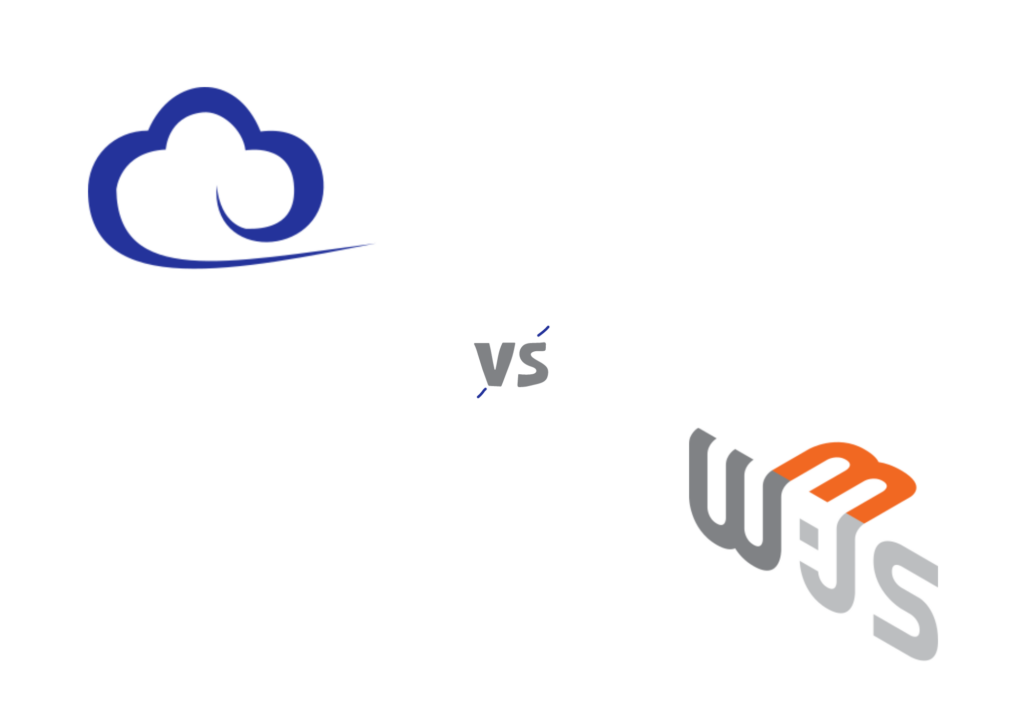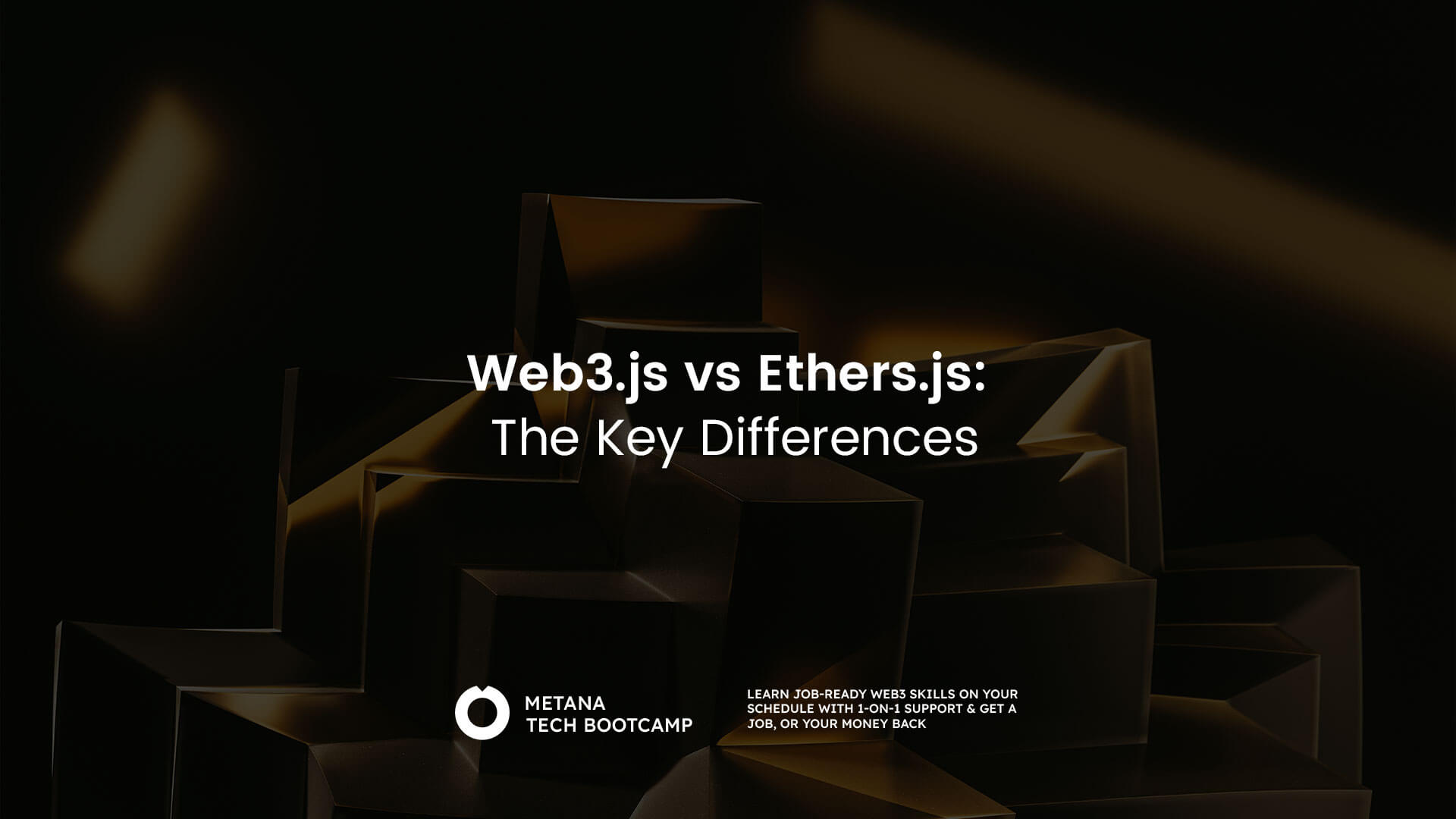Have you ever wondered how innovative applications securely interact with the Ethereum blockchain? At the heart of this interaction are powerful tools known as Web3.js and Ethers.js. These JavaScript libraries are the gateway for developers to dive into the world of Ethereum, enabling a myriad of operations from handling cryptocurrency transactions to deploying smart contracts.
Web3.js is a well-established library, offering a comprehensive suite of functionalities for Ethereum. Ethers.js, a newer contender, is gaining popularity for its user-friendly approach and efficient performance.
As we explore the world of Web3.js vs Ethers.js, you’ll discover how each of them opens up unique possibilities in the blockchain space, and why choosing the right one could be the key to your project’s success.
What is Web3.js?
Imagine you want to talk to someone who speaks a different language, and you need a translator to understand each other. In the world of Ethereum blockchain, Web3.js is like that translator, but for web applications.
Ethereum blockchain is a digital ledger that keeps records of transactions and smart contracts (which are like automated, self-executing contracts). However, it speaks a very technical language that web applications usually don’t understand. Here’s where Web3.js comes in.
Web3.js is a tool (specifically, a JavaScript library) that helps your web application understand and interact with the Ethereum blockchain. It translates your application’s requests into something the Ethereum network can comprehend and vice versa. Here’s what it can do:
- Talk to Ethereum: It connects your application to the Ethereum network, allowing it to send or receive information.
- Handle Transactions: Just like you use online banking to send or receive money, Web3.js lets your application transfer Ethereum’s currency (called Ether) between accounts.
- Interact with Smart Contracts: These are programs that automatically execute certain actions on the blockchain. Web3.js helps your application to use these smart contracts, like voting in a decentralized election or trading digital assets.
- Get Blockchain Info: It can fetch data from the Ethereum blockchain, like checking an account’s balance or looking up past transactions.
For a beginner, think of Web3.js as a bridge that connects the regular internet with the Ethereum blockchain, enabling websites and applications to use blockchain features in a language they can understand.
What is Ethers.js?
Ethers.js is like a friendly, easy-to-use toolbox for the digital world of the Ethereum blockchain. It’s a set of tools (technically, a JavaScript library) designed to help even those new to blockchain technology to easily build applications that interact with Ethereum.
Think of the Ethereum blockchain as a vast, digital universe where Ether (a type of digital money) is exchanged, and smart contracts (automated digital agreements) operate. For most web applications, this universe is too complex to interact with directly. That’s where Ethers.js steps in.
Ethers.js acts as a bridge between your application and the Ethereum blockchain. It’s akin to having a smart digital assistant who simplifies complex tasks. Here’s what it can do:
- Manage Transactions: Similar to using an app to transfer money, Ethers.js enables your application to send and receive Ether, the currency of Ethereum.
- Interact with Smart Contracts: Consider smart contracts as self-executing digital agreements on the Ethereum network. Ethers.js helps your application to read these contracts, execute their functions, and respond to their actions.
- Access Blockchain Information: It allows you to retrieve essential data from Ethereum, such as checking how much Ether someone has or looking into past transactions.
- User Accessibility and Safety: Ethers.js is designed with simplicity and security in mind, making it accessible for newcomers and ensuring that interactions with the blockchain are secure.
For beginners, think of Ethers.js as an approachable and versatile toolkit that makes navigating and utilizing the sophisticated features of the Ethereum blockchain much more manageable and less intimidating.
Pros and Cons of Web3.js
Pros of Web3.js
- Established and Trusted: Web3.js is like the old, reliable tool in the blockchain toolbox. It’s been around for a while, so lots of people have used it and trust it.
- Comprehensive: Think of Web3.js as a Swiss Army knife for Ethereum. It has lots of features, meaning you can do a wide range of things with it, from simple transactions to complex interactions with smart contracts.
- Large Community: Since it’s been around for a while, there’s a big group of developers who use Web3.js. This means lots of resources, guides, and forums are available to help you out.
- Direct Connection to Ethereum: Web3.js connects directly to the Ethereum blockchain. It’s like having a direct phone line to Ethereum, which means you can do a lot with it.
Cons of Web3.js
- Complex for Beginners: With so many features, Web3.js can be overwhelming if you’re just starting out. It’s like walking into a hardware store and not knowing what half the tools do.
- Large Size: Web3.js is pretty big in terms of the file size, which can make applications using it slower to load. It’s like having a heavy toolbox that’s a bit cumbersome to carry around.
- Frequent Updates: The tool is regularly updated, which is good for staying current but can be a hassle because you have to keep updating your knowledge and your projects.
- Callback-Based: Web3.js often uses callbacks, a programming pattern that can be tricky for beginners. It’s like a tool that requires a specific technique to use effectively.
- Limited High-Level Abstractions: For some advanced blockchain features, Web3.js might not provide the simplest solution. You might need additional tools or coding to get certain things done.
In summary, Web3.js is a powerful and versatile library for Ethereum development with a strong community backing, but its complexity and size might pose challenges for beginners.
Pros and Cons of Ethers.js
Pros of Ethers.js
- User-Friendly: Ethers.js is like a friendly guide for your journey into Ethereum development. It’s designed to be more intuitive and easier to grasp, especially if you’re new to blockchain.
- Lightweight: Imagine Ethers.js as a lightweight backpack compared to a heavy suitcase. It’s more compact and quicker to load, making your web applications faster.
- Modern JavaScript Practices: Ethers.js uses newer programming patterns, like Promises and async/await, which are like the latest tools in a toolbox. They can make your coding experience smoother and more efficient.
- High Security Standards: Think of Ethers.js as a secure vault for your blockchain interactions. It has a strong focus on security, which is crucial when dealing with cryptocurrency and smart contracts.
- Rich Feature Set: Despite its simplicity, Ethers.js is like a small box packed with a variety of useful tools. It offers many features needed for robust Ethereum development.
Cons of Ethers.js
- Less Established: Ethers.js is like a newer brand on the market. While it’s gaining popularity, it doesn’t have as long a track record as some older tools like Web3.js.
- Smaller Community: Since it’s relatively new, the community around Ethers.js is smaller. This means there might be fewer resources, tutorials, and community support compared to Web3.js.
- Different API Design: If you’re already familiar with Web3.js, Ethers.js might feel like learning to use a new gadget. Its API (Application Programming Interface) design is different, which can require some adjustment.
- Limited Integration in Some Projects: Some existing projects and tools in the Ethereum ecosystem are built specifically with Web3.js in mind. Adapting them to work with Ethers.js might require extra effort.
In summary, Ethers.js is like a modern, user-friendly toolkit for Ethereum development, offering a simpler and more efficient experience, particularly for those new to blockchain. However, its relative newness means a smaller community and potentially less immediate compatibility with some existing Ethereum projects.

Web3.js vs Ethers.js
| Feature | Web3.js | Ethers.js |
|---|---|---|
| Establishment | Older, more established | Newer, gaining popularity |
| Community Size | Larger community, more resources and support | Smaller community, growing resources |
| Ease of Use | Comprehensive but can be complex for beginners | Designed for simplicity and user-friendliness |
| Size | Larger in file size | More lightweight |
| Programming Style | Traditional callback-based approach | Modern JavaScript features (Promises, async/await) |
| Security Focus | Standard security | High emphasis on security |
| Documentation | Extensive, but can be overwhelming | Clear and well-structured |
| Smart Contract Support | Robust smart contract interaction | Simplified smart contract interaction |
| Transaction Handling | Detailed control over transactions | Streamlined transaction process |
| Blockchain Interaction | Direct connection to Ethereum nodes | Efficient and easy interactions |
| Updates and Maintenance | Frequent updates, possible breaking changes | Regular updates, focus on stability |
This table highlights the key differences between Web3.js and Ethers.js. While Web3.js is known for its robustness and wide adoption in the Ethereum community, Ethers.js stands out for its user-friendly design and modern programming practices. Your choice between the two would depend on factors like your project’s specific needs, your familiarity with JavaScript, and your preference for community support and documentation.
What Should You Choose? Web3.js or Ether.js
When deciding whether to choose Web3.js or Ethers.js for your Ethereum-based project, consider the following factors:
1. Your Experience Level in JavaScript and Blockchain
- Beginners: If you’re new to JavaScript or blockchain development, Ethers.js might be a better choice. Its user-friendly design and modern JavaScript practices make it easier to grasp.
- Experienced Developers: If you have experience with blockchain development or are comfortable with complex JavaScript, Web3.js’s comprehensive features might suit you better.
2. Project Requirements and Complexity
- Complex Projects: For projects requiring detailed control over blockchain interactions, Web3.js’s robustness and extensive feature set might be more appropriate.
- Simpler Applications: If your application needs basic blockchain interactions and you prefer a more streamlined, efficient library, Ethers.js is likely the better option.
3. Security Concerns
- High Security Projects: Ethers.js is known for its strong emphasis on security, making it a preferable choice for applications where security is a top priority.
- Standard Security Needs: For general projects, Web3.js offers adequate security features.
4. Community Support and Resources
- Extensive Community Support: Web3.js has a larger community and more resources, which can be beneficial for troubleshooting and support.
- Growing Community: Ethers.js, while having a smaller community, is growing and has well-structured documentation.
5. Familiarity with the Library’s API Design
- Preference for Modern JavaScript Features: If you prefer using Promises and async/await, Ethers.js aligns more with modern JavaScript trends.
- Comfort with Traditional JavaScript Patterns: If you’re more comfortable with the traditional callback-based approach, Web3.js would align more with your programming style.
6. Consideration of Future Maintenance and Updates
- Regular Updates: Both libraries are regularly updated. Web3.js updates can sometimes introduce breaking changes, so be prepared for ongoing maintenance.
- Stability in Updates: Ethers.js tends to focus on stability with its updates, which might be preferable if you want to minimize maintenance efforts.
Conclusion
In summary, when diving into Ethereum blockchain development, the choice between Web3.js and Ethers.js depends on your project’s needs and your expertise. Web3.js offers a comprehensive toolkit with a strong support community, ideal for complex projects and experienced developers. Ethers.js, on the other hand, shines with its simplicity and modern JavaScript practices, making it a great choice for beginners or projects prioritizing ease of use and security. Both libraries are robust and capable, but your individual project requirements and personal programming style will guide you to the right choice in this evolving landscape of blockchain technology.

FAQs
What are the key differences between web3.js and ethers.js?
- Web3.js and ethers.js differ in their design philosophy, API simplicity, and bundle size. Web3.js is more established, while ethers.js is known for its lightweight design and user-friendly API.
Is ethers.js faster than web3.js?
- Ethers.js is often considered faster and more efficient due to its smaller bundle size and streamlined API, making it a preferred choice for performance-oriented applications.
Can I use both web3.js and ethers.js in the same project?
- Yes, it’s possible to use both in the same project, but it’s generally more efficient to stick with one to avoid redundancy and potential conflicts.
Which is more beginner-friendly: web3.js or ethers.js?
- Ethers.js is often regarded as more beginner-friendly due to its simpler and more intuitive API, making it easier for new developers to grasp.
Do web3.js and ethers.js support all Ethereum networks?
- Both libraries support main Ethereum networks and test networks, making them versatile for various development environments.
What is Ethereum blockchain development?
- Ethereum blockchain development involves creating decentralized applications (DApps) and smart contracts on the Ethereum blockchain, using languages like Solidity and tools like web3.js and ethers.js.
Why are JavaScript libraries important in blockchain development?
- JavaScript libraries like web3.js and ethers.js simplify interacting with the Ethereum blockchain, enabling developers to build DApps and interact with smart contracts more easily.
What are smart contracts in the context of Ethereum?
- Smart contracts are self-executing contracts with the terms of the agreement directly written into code, running on the Ethereum blockchain, enabling trustless and automated transactions.
How do I choose the right library for my blockchain project?
- Consider factors like your project’s size, performance needs, team’s familiarity with the library, community support, and specific features you need.
Are there any prerequisites to using web3.js or ethers.js?
- Basic knowledge of JavaScript and understanding of blockchain concepts are essential. Familiarity with Ethereum and smart contract development is also beneficial.








